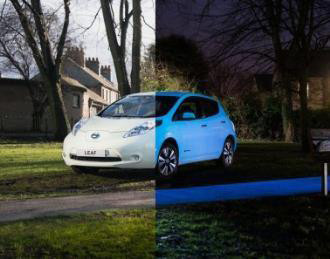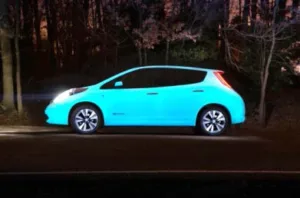I recently opined to a group of display industry experts that I thought “the next big thing” in the display industry was not going to be related to some incremental improvement related to high-information-content image quality or performance.

It was instead going to be related to very low-information-content technology that could be inexpensively deployed across wide-area electronic systems – things like electronic wallpaper, carpeting,automobile finishes, and the like…Basically, I think that by electronically changing color or enabling simple changes to design patterns, huge surfaces can be transformed into display solutions. Already, we’re seeing innovations related to lighting technologies thatallow for display-like control of lighting systems, both in the home and in public places.
Well, my opinion resulted in comments from the “experts” that such applications are not really displays – as “they don’t convey information”. I beg to differ. Although there is no-one who is a bigger fan of high performance displays than me, simple changes of color or low-information-content changes of pixel output – such things definitely convey information. Perhaps it’s not full-color, video output in 3D, but such low information solutions are quite compelling – and they are coming. Consider one recent example from Nissan: A configuration of the Nissan Leaf electric car has been given a paint job that appears normal in the light, but glows green in the dark. The glow-in-the-dark paint is said to be made up of entirely organic materials. According to Nissan, drivers of the all-electric Leaf are increasingly installing solar panels at home and charging their cars for free. The glow-in-the-dark Leaf is aimed at drawing attention to this.
The car was designed in partnership with inventor Hamish Scott, who previously created the Starpath glow-in-the-dark spray-on coating for footpaths and roads. The paint for the car reportedly contains much the same ingredients as his Starpath spray. Among the active ingredients in the paint is strontium aluminate, a solid, odorless and chemically and biologically inert compound that is widely used in glow-in-the-dark materials. The paint absorbsUV energy when it is light and can glow for between eight and 10 hours in the dark. Scott sees a host of potential safety uses for the coating, such as to improve visibility of bikes and boats. http://www.nevanadesigns.com/
Nissan created a glow-in-the-dark Leaf So is a “paint” that glows-in-the-dark a form of a display? I’m not sure. But I remain confident that suchinnovations are coming, creating huge opportunities for large-area electronics built on flexible substrates andsurfaces that require conformable solutions. This segment of the market is prepared for a huge boom! – Mark Fihn
Thanks to Mark for this guest appearance on Display Daily. Mark is an industry veteran and principal of http://www.veritasetvisus.com This editorial in his newsletter reminded me of a visit I made to the MIT Media Lab, many years ago, when the SID was held in Boston. There was a lot of work at the time going into very low information content “ambient” displays (and audio). For example, there might be something that glowed gently when an email was waiting, or change in the sound of some water. The idea was to give clues to what was going on in a natural and easy to live with way.
Steve also covered the way E Ink technology is also being used for decorative purposes. (E Ink Plays to its Strengths – subscription required) (BR)


